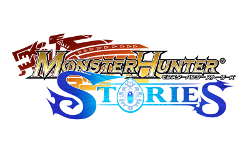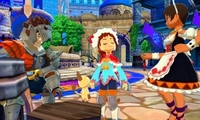|
|

|
PLATFORM
|
3DS
|
BATTLE SYSTEM
|

|
INTERACTION
|

|
ORIGINALITY
|

|
STORY
|

|
MUSIC & SOUND
|

|
VISUALS
|

|
CHALLENGE
|
Hard
|
COMPLETION TIME
|
40-60 Hours
|
|
OVERALL

|
+ Gorgeous in every single visual aspect
+ Heart-warming theme of friendship
- Combat system only allows so much control
- Bland collect-a-thon mission structure
|
Click here for scoring definitions
|
|
|
As someone who has tried and failed to be taken in by the Monster Hunter gameplay formula of kill monsters and gather materials to take on bigger and badder foes, hearing about a series offshoot with more traditional turn-based RPG elements sounded like this could finally be my in to the series. If my first hour with Monster Hunter Stories was anything to go by, I was going to love this emotional adventure set in an extremely gorgeous world. Forty-something hours later, I've come to the conclusion that, despite some variance in gameplay mechanics, this game will still appeal more to long-time series fans than any newcomers, largely due to its mission-to-mission gameplay that is, by design, repetitive and a combat system that never quite gelled with me.
The game tells the story of a young silent protagonist, created by the player, and his or her two best friends, Lilia and Cheval. One day, the friends head out into the wilds to play at being Riders, humans with the ability to hatch monsters from eggs and creating a lifelong bond of kinship with them. Finding a monster egg in its nest, they are surprised when it actually hatches, and the freshly-hatched Rathalos inside chooses the player character as his bonded friend, becoming his constant companion in the process. This is one of the main ways the game distinguishes itself from the main series, and locating monster nests to steal eggs to hatch becomes one of the game's main gameplay mechanics. Using this approach, players can collect unique monsters, which can then be taken into battle to earn experience and level up. In this way, Monster Hunter Stories is much more akin to the Pokémon franchise, and will more readily appeal to the latter's audience.
The story, such as it is, quickly takes a darker turn after its cute and benign opening. After the friends return home with their Rathalos, the village is savaged by a beast suffering from the Black Blight, ending in personal tragedy for one of them, and causing their lives to change from that moment on. It's from here that the story's main goal kicks off. With the lovable Felyne Navirou in tow, who acts as the silent protagonist's interpreter and comic relief, the player character becomes a Rider, one of the few people able to forge a kinship bond with Monsties — what the game dubs the bonded allies. This is the game's gimmick, and completely different from the series' familiar Hunters, who simply slay beasts. Over the course of the lengthy narrative, the game takes pains to point this distinction out again and again, making the bond of friendship between Riders and their Monsties the central theme. But to get this tale off the ground and level up their Monstie pals, it's time for the player to go out there and indiscriminately kill, kill, kill. The idea of kinship is nice, but it's undermined somewhat by the traditional genre convention of killing the very monsters that can be bonded with to earn experience.
 Monsties, even the most ferocious ones, are equal parts cute and deadly.
Monsties, even the most ferocious ones, are equal parts cute and deadly.
|
|
Combat in Monster Hunter Stories follows a rock-paper-scissors approach, here dubbed power, speed, and tech. Tech trumps speed, speed beats power, and power bests tech. While this is a very simple underlying combat design, there are many layers on top of this to give the system more legs. For example, each Monstie has its own unique combat abilities, as does the player character, which can be chosen on the fly. While players only have one Monstie active in battle at a time, Monsties can be switched out from several that are in the current combat party; at the end of each battle, each Monstie in the party will receive experience, whether they participated in battle or not. The Rider also has several combat abilities, which depend on the equipped weapon type. Finally, Riders can, as their name implies, ride their Monstie. This can be done on the overworld map for transportation, or during combat once a Kinship Gauge has been filled. Riding a Monstie increases stats and allows for a special kinship skill to be performed, a powerful move unique to each Monstie.
Although the combat system isn't broken per se, it leaves a lot to be desired in practice. For starters, knowing which move to use in battle is an educated guessing game at best. Enemies don't telegraph which move they're planning when they attack the Rider directly, making it, at worst, a process of trial-and-error to choose the correct retaliation. Some monsters do have patterns, but bosses can be especially unpredictable. The biggest issue comes in the lack of control over Monstie allies. Monsties will attack whomever and however they choose, with no way to direct them in casual combat. The only ways to steer a Monstie attack are to use up the Kinship Gauge to assign special abilities, or to let the gauge fill and ride them, making them obey basic battle commands. While it's true that combat can be won even with erratic Monstie behavior and each Monstie has a predilection for one type of attack over the others, it still equates to a general lack of Monstie control, which can be disastrous in some late-game boss battles.
A completely separate hurdle from the hit-or-miss combat system is the game's slow-paced progression, particularly where its subquests are concerned. The game is absolutely brimming with content, from the "gotta catch 'em all" collect-a-thon monster hunting to the hundreds of subquests that can be accepted from townsfolk or a mission board. Sadly, there's very little here that provides a narrative payoff; the vast majority of quests require collecting items or slaying numbers of creatures. What's worse, slews of missions usually appear right after clearing a story dungeon, all requiring the player to return to the dungeon to slay the same creatures already killed, but not credited since the quests weren't yet available. Setting out from the Rider's home village for the first time, I found myself faced with an open world and nonplussed as to what I was actually supposed to accomplish. The answer was to whittle away at the subquest log little by little, then return to town for more, eventually leveling and moving on with the critical story path, a structure probably familiar to players of previous Monster Hunter titles, but not a particularly attractive way to experience the story for the rest of us.
 The game's graphics are bright, bold, and endearingly colorful.
The game's graphics are bright, bold, and endearingly colorful.
|
|
If there's one area in which Monster Hunter Stories unquestionably receives top marks, it's in the graphics department. The game is absolutely gorgeous to look upon at any given moment, no matter if it's during combat, on the field map, or in one of its even more polished cinematics. The overall graphical style is reminiscent of Wind Waker, minus the heavy cel-shading outlines; bright and bold colors dominate, animation is fluid, and effects all impress. Considering there are over one hundred Monsties to recruit into the Rider's ranks, and each has unique animations depending on the attack type, special abilities, and status effects in play, not to mention another set of animations for the Rider, it's already an impressive visual feast. But when one also considers that all weapons and armor are shown even during cinematics, as well as the fact that the Rider is created via a pretty well-stocked character creator, and that each Monstie has a unique kinship skill animation comparable to a summon spell, the animation department's sheer effort and dedication become even clearer. Musically, the game scores a little lower — areas have distinct themes, but there's little that actually stands out, apart from the main fanfare. It's all very well orchestrated, but once the credits roll, it doesn't leave many lasting impressions. The main cast does feature voice acting in some scenes, speaking in the same gibberish language familiar to fans of the series. Despite being incomprehensible, the voice actors do a good job portraying their characters, like Navirou's can-do attitude no matter the situation, or the mad scientist and his numbskull sidekick.
There are a lot of odds and ends one discovers over the course of the game, for better or worse. The game is packed with content, quite a bit of it extending beyond the main campaign's runtime. Not only can players go back to complete any of the hundreds of subquests, but finishing the game opens up a whole new tier. That's not even mentioning not one but two post-game dungeon areas, stuffed full of suitably challenging foes. There are many collectables to find, Monsties to hatch, and gear to forge. Dedicated players will easily be able to pour dozens upon dozens of additional hours into the game, and when all of that grows stale, there are DLC quests and online matches to participate in. Capcom and Marvelous wanted to turn over a new leaf, and Monster Hunter Stories certainly is that, a departure from what has come before, it just wasn't enough of a departure for my taste. The franchise faithful will probably still feel at home here, but others may need to decide if they can stomach the guesswork combat system or rote mission structure before committing to this game.
Review Archives
|









